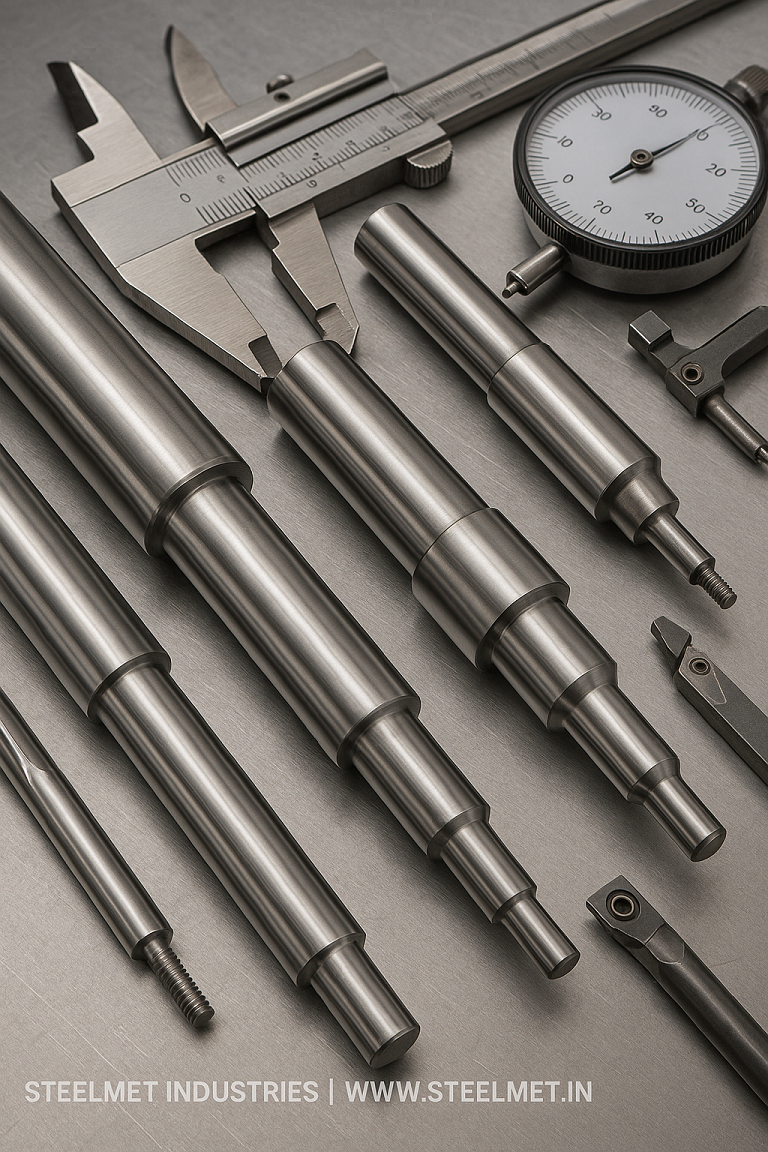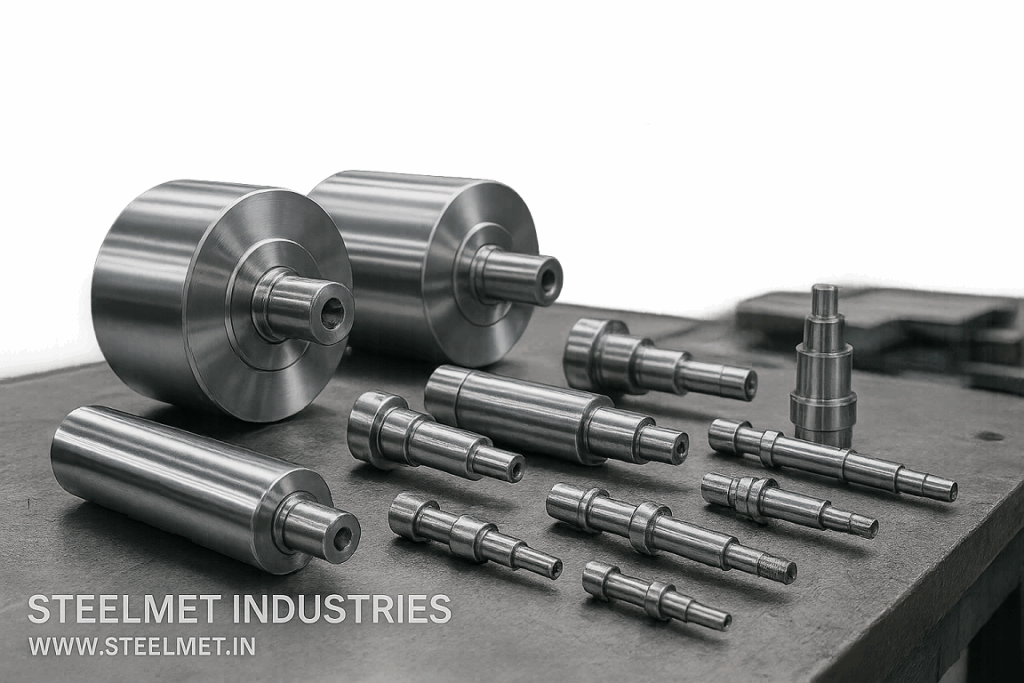Bright Steel Bars for Ginning, Textile, Food Processing & Packaging Machinery
Machinery used in ginning, textile manufacturing, food processing and packaging requires components that operate with controlled dimensional accuracy, stable hardness and reliable surface finish. Bright steel bars are used for rollers, shafts, spindles, knives, guides, couplings, timing shafts and high-speed rotating parts. Their uniformity and machinability help ensure smooth operation, reduced vibration, improved hygiene compliance and consistent load-bearing performance across continuous-duty machines.

Bright steel rollers, shafts and guides prepared for use in ginning, textile, food processing and packaging machines.
Primary Applications
- Ginning machine rollers, shafts and beater components
- Textile machinery spindles, guides, shafts and drive parts
- Food processing equipment shafts, mixer blades, rotating elements and guides
- Packaging machinery rollers, timing shafts, cam followers and sealing components
- Conveyor shafts, bush-contact components and structural fittings
- Precision machined parts used in hygienic or continuous-duty environments
Component Groups & Child Pages
Ginning Machinery Rollers & Shafts
Ginning rollers and shafts require straightness, controlled hardness and good fatigue resistance to handle cyclic loading, vibration and abrasive fibre movement.
Textile Machinery Shafts, Guides & Spindles
Textile machines rely on high-speed spindles and low-vibration shafts. Bright bars deliver predictable OD, concentricity and machinability for precise fits.
Food Processing Equipment Shafts & Rotors
Food-grade components require predictable surface finish and materials that support coating, plating and hygienic processing where required.
Packaging Machinery Rollers & Timing Shafts
Packaging machines depend on smooth rollers, accurate timing shafts and torque-stable components to maintain consistency in high-speed production lines.
Why bright bars are preferred in ginning, textile and food grade machinery
- Reduced vibration due to improved straightness and concentricity of shafts and spindles.
- High machinability allows consistent profiling of rollers, guides and timing components.
- Predictable surface finish supports plating, nitriding and coatings used in hygienic applications.
- Stable metallurgical properties enable repeatable heat treatment for wear and fatigue control.
- Lower machining allowance supports high-volume repeat parts with reduced cycle times.
Real-world use case
A packaging OEM adopted EN8D and EN19 bright bars for high-speed sealing and cutting shafts. Machining time reduced due to better surface condition, runout dropped significantly and the components performed more consistently after surface nitriding.
Quick decision pointers
- For ginning rollers and spindles: Choose C45 or EN8D for general-duty use; EN19 for heavy-duty shafts.
- For textile machine spindles: EN8D offers stable machinability; EN19 preferred for high-torque zones.
- For food processing equipment: Use bright bars with controlled surface finish for plating and hygienic coatings.
- For packaging rollers: EN19 or EN24 where fatigue resistance and stable hardness are required.
Failure-prevention and quality notes
- Ensure straightness and runout for high-speed spindles and timing shafts.
- Define surface finish requirements for coated or plated food-grade components.
- Confirm core hardness and toughness for heavily loaded ginning rollers.
- Use controlled heat treatment for EN19/EN24 to avoid distortion in long shafts.
- Inspect for surface defects to avoid abrasive wear in textile and ginning machinery.
Standards & Equivalents (Table 1)
| IS | BS970 | AISI / SAE | DIN / EN | JIS | GOST | GB |
|---|---|---|---|---|---|---|
| C45 | EN8 | 1045 | C45E / 1.1191 | S45C | 45 | 45# |
| EN8D / C40 | 080M40 | 1040 | C40 / 1.0511 | S40C | 40 | 40# |
| EN19 | 708M40 | 4140 | 42CrMo4 / 1.7225 | SCM440 | 40Х | 42CrMo |
| EN24 | 817M40 | 4340 | 34CrNiMo6 / 1.6582 | SNCM447 | 40ХН2МА | 34CrNiMo6 |
| EN31 | 070M55 | 52100 | 1.3505 | SUJ2 | ШХ15 | GCr15 |
Grade Selection, Performance & Heat Treatment (Table 2)
| Grade | Typical Application in Ginning/Textile/Food/Packaging | Performance Indicators | Typical Heat Treatment Route |
|---|---|---|---|
| EN8D / C40 | Suitable for general-duty rollers, guides, shafts and components with moderate loading and high machining needs. | Machinability: High | Hardenability: Low | Wear Resistance: Moderate | Fatigue Strength: Moderate | As-drawn or normalized; optional nitriding or plating. |
| C45 / EN8 (1045) | Used for textile and packaging rollers, mixing shafts and repetitive-duty components requiring balanced toughness. | Machinability: Medium | Hardenability: Medium | Wear Resistance: Moderate | Fatigue Strength: Moderate | Normalize or Q&T; surface finishing for food-grade use. |
| EN19 (4140) | Ideal for high-speed shafts, timing components, torque-loaded packaging parts and heavy ginning rollers. | Machinability: Medium | Hardenability: Good | Wear Resistance: High | Fatigue Strength: High | Q&T; controlled tempering for fatigue-critical parts. |
| EN24 (4340) | Used where impact, torsion and load variation demand high toughness — including certain ginning and packaging shafts. | Machinability: Medium/Low | Hardenability: Excellent | Wear Resistance: Very High | Fatigue Strength: Very High | Q&T; optional sub-zero treatment for long-life spindles. |
| EN31 / 52100 | Suitable for wear-intensive rollers, bush-contact components and abrasion-exposed textile parts. | Machinability: Low | Hardenability: Excellent | Wear Resistance: Very High | Fatigue Strength: Very High | Through-hardening and tempering; precise control of retained austenite. |
Inspection & manufacturing checklist
- Check straightness and runout for high-speed textile spindles and packaging rollers.
- Define Ra values for food-grade components needing plating or coating.
- Ensure correct hardness for ginning rollers and bush-contact areas.
- Verify heat-treatment cycle for EN19/EN24 to prevent distortion.
- Inspect surface defects to avoid abrasive damage in textile machines.
Frequently Asked Questions
Which grade is best for textile machine spindles?
EN8D is widely used due to its machinability and dimensional stability; EN19 is preferred for high-speed or high-torque sections.
What grades are suitable for food processing applications?
C45 and EN8D bright bars are common for rotors and mixing shafts where plating or coating is applied for hygiene.
Is EN19 suitable for ginning rollers?
Yes. EN19 provides higher toughness and fatigue resistance, making it suitable for heavy-duty ginning environments.
Contact for Ginning, Textile & Food Machinery Components
For rollers, spindles, shafts, guides or precision components used in ginning, textile, food processing or packaging machinery:
Related: All application categories — Industrial Machinery Components — Heavy Engineering & Earthmoving

